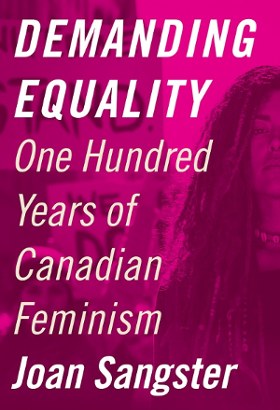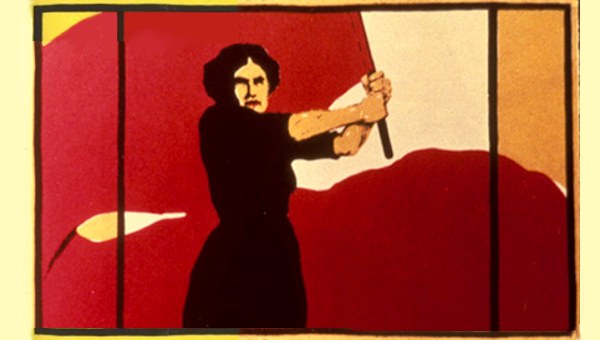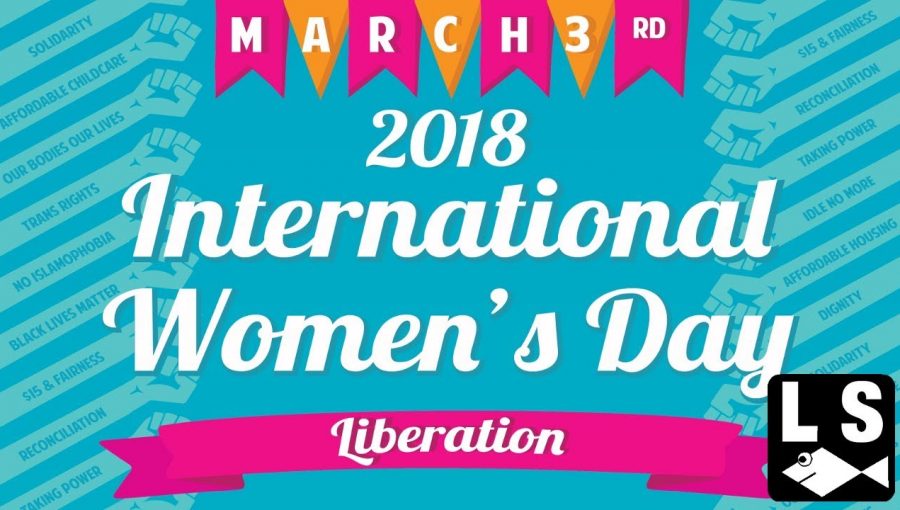Beyond McFeminism: The Socialist Origins of IWD in Canada
When a California McDonald’s marked International Women’s Day (IWD) in 2018 by inverting its big M to a W, some happy meal consumers tweeted that it should stick to hamburgers not political correctness, but the media also zeroed in on the rank hypocrisy of a corporation that did not pay a living wage or provide healthcare to its precarious, racialized, female workforce. “McFeminist” initiatives by the private and the non-profit sectors to cash in on international women’s day, a time to “celebrate that special woman in your life,” as one hospital fund raiser put it this year, are routine. Even Netflix has joined the festivities, offering a montage of “women firsts” in the movies, a gloss on Hollywood’s history of sexism and racism.
Examples like McDonald’s are easily denounced, and to be clear, feminism has long been commodified by business interests, though feminists have also pushed back, no more so than in the 1960s and 1970s. In Canada, protests of “ad-man idiocy” marketing that played on the ‘liberated woman’ trope made their case through word and deed. The “Feminist Fighting Force” crashed a Macdonald Tobacco event at Toronto’s tony Hyatt Regency Hotel in March, 1974, registering their disgust with sexist “Contessa” cigarette promotion.
But a more subtle trend than crass McFeminism has been the incorporation of International Women’s Day into a liberal politics that lacks a meaningful critique of neoliberal capitalism and colonialism, and downplays the historic link between IWD and socialism. The buzzwords associated with these events include references to “leadership, empowerment, achievement,” as well as a vaguely-defined “inclusivity and diversity.” Some at least reference “women’s equality” as important, but many events package IWD as a liberal, achievement-oriented notion of progress. One of the more jarring events, “Women & Wealth Gala” put on by “Women & Wealth Inc.” celebrates and “empowers” women on their way up to becoming leaders in business, governments and other sectors. Clara Zetkin would surely turn over in her grave. Perhaps it is time, not to lay Zetkin to rest, but revive something of her vision.

The Making of IWD
German socialist, later communist Zetkin was the inspiration behind a 1910 resolution at the Second International Socialist Women’s Conference to mark an international women’s day to “agitate” for women’s suffrage, always from an internationalist, socialist approach. Zetkin and other feminist-socialists hoped to wean working-class women from the tempting fallacy of bourgeois feminism and remind recalcitrant socialist men that suffrage was worth fighting for. American antecedents inspired these European socialists. Both the Socialist Party of America and militant garment unions organized similar “women’s day” protests calling for women’s political and workplace rights in 1908 and 1909. Canadians did not demonstrate in the streets but a socialist feminist tradition was already in the making. Women associated with the Socialist Party of Canada and Social Democratic Party of Canada joined with feminists to demand the vote, but also promoted a socialist vision of working-class mobilization and emancipation.
From 1911 on, IWD assumed different origins stories, shaped by changing feminist, socialist and communist agendas, though IWD was most consistently situated in a Left-wing politics. Pre-revolutionary feminists and socialists in Russia both conflicted and cooperated with each other on IWD events, while the celebrated February 1917 women’s strikes that sparked revolutionary protest were re-interpreted over time according to Bolshevik and later Stalinist priorities. After the 1917 Revolution, IWD was promoted by Soviet leader Alexandra Kollantai as a communist, internationalist project, an association that lasted for decades.
In Canada, IWD celebrations in the 1920s were, like the Communist Party, multilingual: performed in Ukrainian, Yiddish, Finnish and English, they were platforms to indict the oppression of women, in their view originating in capitalist exploitation and European imperialism, and to advertize working women’s struggles around the world. Profiles of women like Rosa Luxemburg in communist newspapers created a message of women’s collective empowerment within the international communist left, though she was later replaced by more palatable icons for a party politically indebted to the USSR.
Communist efforts to broaden their reach during the Popular Front elicited cooperation with progressive, socialist, and anti-fascist women. IWD was used to fashion a coalition against fascism, analyzed not only as a danger to world peace and socialism, but also to the paltry rights women had so far secured. Fascism, one Canadian socialist feminist warned, reduced women to “selected breeders,” relegated to “Kinder, Küche, Kirche” (children, kitchen, church).
Anti-fascist messages persisted during World War II in many countries. Dissident, anti-fascist women sent by the Nazis to the Ravensbrück concentration camp marked IWD in secret. During the Cold War, IWD had a presence in some socialist groups, but it was still associated with the (Soviet) communist left, through the Women’s International Democratic Federation, which, despite its Soviet influence, had links to anti-colonial activists in the “Third World,” and national communist parties – in McCarthyist Canada, a beleaguered group. One reason IWD historical origins were re-invented yet again in the 1950s, with claims that it emerged from women’s strikes in 1857, was an effort to sever IWD from its decades-long communist association.
New Start
Resurrected in the 1970s by the next political generation, IWD assumed new meanings and modes of organizing, but it still recognized its socialist history, not the least because socialist-feminists, with roots in Marxist feminism, the New Left, and international socialist protests like 1968, were a vital part of IWD (and more broadly feminist) organizing. Other feminist ideologies and strategies were also part of the mix; indeed, intense debates over the role of men in IWD, imperialism, anti-racism, and definitions of feminism transpired. However, Zetkin was reclaimed as the socialist instigator of IWD and socialism and social democracy were very much part of the political debate. In some cities, IWD moved from a one-day event to a year-long organization. In 1979, the Toronto committee declared itself a “socialist-feminist organization committed to mass action,” but IWD organizations varied across the country, with some cities espousing more pluralistic, political coalitions necessitated by local conditions.
The commitment to sharp political critique and on-the-ground protest were both present in IWD organizing, along with efforts to celebrate a vibrant feminist counter culture. Feminist newspapers which proliferated in the 1970s and 1980s took IWD’s oppositional stance seriously. One of the earliest, Vancouver’s Pedestal, insisted in 1972 that IWD must be recognized as part of a long history of working-class women’s struggles, stretching from the British matchgirls’ strike of 1888 to British Columbia relief strikes in the thirties and wartime women workers demanding daycare and equal pay. In 1978, BC’s Kinesis advertized Vancouver IWD’s focus on the exploitation of women’s labour: women’s unemployment, low pay, the need for unions, fully subsidized daycare, the unrecognized, unpaid work of homemakers, and the need to resist state rollbacks hurting the working class. A few years later, Kinesis did an IWD scan of women’s struggles around the world, publishing articles that did not shy away from a critique of “imperialism” abroad. Other IWD articles pinpointed colonialism at home, including the discriminatory Indian Act provisions that deprived Indigenous women of their birthright status.
Many feminist papers, though not endorsing any one socialist or new communist party, assumed IWD must encompass socialist and social democratic perspectives. Ottawa’s Upstream covered the 1978 IWD demonstration, highlighting the key issues: women’s right to work, Indian Rights for Indian Women, alternative women’s socialist unions and anti-poverty struggles. Incensed with CBC coverage of their events, feminists picketed broadcast headquarters two days later, protesting media silence about the keynote speaker from the feminist and socialist union, SORWUC, while the more lacklustre Canadian Labour Congress was given coverage. This critique of the labour movement status quo, along with an uncompromising rejection of the military and all militarization, both part of many IWD protests, would be unlikely today.
An on-the-ground tradition of protest, which included some critique of capitalism and colonialism, persisted in many IWD protests in the 1990s – and to this day. There are still efforts to build coalitions that connect feminism to anti-racist, anti-colonial and anti-imperialist protests, as well as other social movements. Working-class and anti-colonial struggles are, in the current moment, visible and vibrant, from Amazon workers unionizing to Indigenous women’s project of decolonization.
However, there is no doubt that socialist-feminism, as activism and analysis, was somewhat diminished in Canada after the 1990s. Unlike some American feminists who claim socialist feminism had a natural “affinity” with some of the tenets of neoliberalism, I do not think socialist feminism was absorbed or “coopted,” as much as it was marginalized, in part due to changes in feminist theory and critiques of socialist feminism’s own failures vis-à-vis an anti-racist analysis, but also in concert with the decline of the global left, state and business assaults on the working class, and the debilitating dominance of neoliberalism.
Pandemic Feminist Discourse
Keeping socialist feminism, part of the IWD tradition, alive, is more important than ever given the hegemonic sway of both liberal and neoliberal feminist talk during the current pandemic. Sure, the mainstream press has suddenly discovered that paid care work is undervalued, that women assume more familial care, that women are more likely to abandon paid work, and that racism and colonialism heighten the pandemic vulnerability and suffering of these groups. But these discussions are not necessarily connected to a more radical political analysis. There is no robust class analysis, critique of the resilient structures of economic and social power, or any vision of socialist transformation.
Useful discussions on the immediate needs of women and workers have emerged from groups like the YWCA. Collaborating with the Rotman School of Management, their “Feminist Economy Recovery Plan for Canada,” echoes social democratic calls for significant investments in child care, well-paid jobs, small businesses led by women and racialized people, as well as attention to systemic racism, including implementing recommendations of the Murdered and Missing Women and Girls Inquiry Report – and more. Many of these proposals would be welcome, immediate aids to women and workers. Any demand for urgently-needed resources for agencies combating gendered violence cannot be argued with. Implementation is not unimaginable from a social democratic government unafraid of raising taxes and making public investments, though we have come to doubt the NDP will ever be that brave.
Everyone seems to be getting in on this feminist recovery plan bandwagon, suddenly worried about women workers leaving the workforce, including the Canadian Chamber of Commerce with its “She Recovery Act.” The call to “Build Back Feminist” (a term with fitting links to Biden), promoted by the federal Liberals, epitomizes this liberal feminist thinking. A recent IWD panel sponsored by the Canadian High Commission in London on this topic stressed equal access to training and education, revised gender norms, and the inclusion of women in policy making. Notwithstanding some panelists call for urgent attention to the climate crisis or the need for major “structural change,” much of the discussion focused on calls for a more “compassionate” society with no “discrimination.” “Diversity” is also mentioned (always), as is “intersectionality,” fast becoming a vacuous buzzword in the media.

The message from the Liberal cabinet minister, a former Liberal MP and an executive with the Bank of Canada, was that feminism meant “equal access to power, authority, resources,” the removal of barriers to advancement, equal educational access, and the inclusion of women in transparent, policy making leadership. Changing “gender norms and thinking” or what we used to call “socialization” (also cited in the federal government’s recently announced “feminist recovery fund”) was also needed. Having more women in powerful policy making roles would produce a “richer,” woman-oriented, perspective. Richer for whom is the question? Not the vast majority of working women.
Similar suggestions about education, socialization and policy making were voiced by reform-minded feminists in the 1920s and 1950s. However they are not simply ‘old’: they are market-compatible, liberal notions of equality, in which equality of opportunity, not equal outcomes, let alone the abolition of a class system, is the goal. They do not offer any radical challenge to the neoliberal pressures on paid and social reproductive labour. Rather than abolishing hierarchies of power, they suggest pathways to some women’s influence. Capitalism, in other words, has temporarily run amok for women and racialized groups, but don’t’ worry: it can be fixed. We just need smart, feminist women to join the men in charge.
“Build Back Feminist” is not so much a solution as a problem, given how dominant and loud this perspective is. Child care, living wages, anti-racist initiatives are urgent necessities, but they are starting points, not a final destination of transformative change. Socialist-feminist discussion and organizing, which were never homogenous, but rather a chorus of ideas, are needed more than ever. As we recall IWD’s long socialist history, perhaps more utopian visions are needed. It may be time to honour Zetkin’s original socialist intent by “dreaming bigger” than limited feminist reforms that do not challenge either capitalism or colonialism in meaningful ways.
Feminist newspaper quotes taken from Pedestal, Kinesis and Upstream, all available at Rise Up! feminist digital archive.
Records of many IWD groups across Canada are in the Canadian Women’s Movement Archives in the University of Ottawa Archives. •





